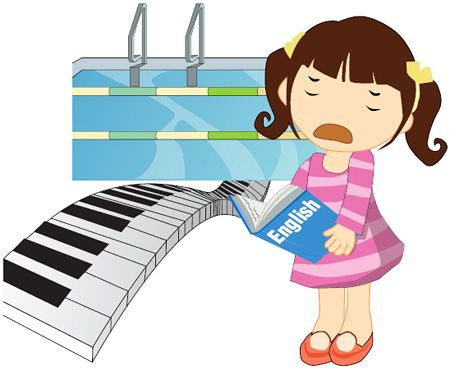‘Education poor’ on sharp rise
Middle-class parents pressed to cope with costly private tutoring
Kim Ji-hye is 6. She attends a neighborhood preschool in Ilsan, Gyeonggi Province. She has a busier schedule than her parents because her mother wants to keep her focused on learning.
After finishing preschool at around 2 p.m., she rushes to an indoor pool for a one hour swimming class. After that she has a piano lesson, also for about an hour. To save time, Kim does homework while waiting her turn at the piano.
English tutoring is next, meaning she returns home at around 7 p.m. On weekends she goes to fine arts class. She recently applied to a private elementary school in Seoul, where she would commute for about an hour every day. The school would charge her parents about 1 million won per month.
Kim’s parents spend about 1.5 million on educational expenses for her. Regarding additional playschool costs for her 3-year-old brother, their outlay tops 2 million won per month.
This excessive education fever is not isolated to Kim’s family. Many Korean parents spend more than they can earn and borrow to pay for their children’s education, which has increased the number of the so-called “education poor.”
The problem is that a growing number of middle-class households have become “education poor” because they are struggling with excessive education-related expenses as they try to save for retirement.
According to a recent survey by Teacher Yoon last month, 56.6 percent of respondents said they classified themselves as education poor. About one-fourth of those said they spent between 500,000 and 600,000 won on education expenses for each child every month. 19.1 percent of them said they pay between 400,000 and 500,000 won.
More than half of the respondents said they are under excessive pressure due to education expenses, while 38.3 percent of them said their stress is normal. Among the education poor, one-fifth said they borrowed from relatives, acquaintances, credit card firms and banks to pay for the expenses.
Of the respondents, 46.3 percent pointed out that the nation’s degree-obsessed social culture is the key reason behind the education fever.
IBK Investment and Securities said last month that Korea’s private education market will increase 1.9 percent to 36.9 trillion won next year from a year earlier in its 2013 outlook report on education.
According to data from the Organization for Economic Cooperation and Development (OECD), Korea’s private expenditure on education marked 2.8 percent of its gross domestic product in 2011, topping the list among 28 countries surveyed. The figure was three times the OECD average of 0.9 percent.
However, the country’s public expenditure on education reached 4.7 percent, lower than the organization’s average of 5 percent, showing an imbalance between public and private expenditure.
This is in stark contrast to European countries, which rely heavily on public rather than private expenditure. For instance, Sweden’s private expenditure on education was just 0.2 percent of its GDP, while its public expenditure on education posted 6.1 percent.
The problem is, experts say, that Koreans are afraid of higher taxes to pay for increased public expenditure on education, while they are willing to spend money on private education.
“It is weird. Korean taxpayers are reluctant to pay more taxes for public expenses on education while they spend lots of money on their children,” said an economist at a local private think tank.
Politicians and the government have sought to solve these problems, but most of their efforts have ended in vain. Recently former presidential contender Ahn Cheol-soo said that Korea is losing hope because the middle class suffers from excessive educational expenses, vowing to reform the notorious system. <The Korea Times/Kim Jae-won>






















































